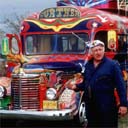Ken Kesey, 1935-2001The hero of US counterculture and author of One Flew Over the Cuckoo's Nest has died at 66
Christopher Reed Fuelled by psychedelic drugs and dressed in a jester's outfit, Ken Kesey, who has died aged 66 of liver cancer, embodied an ancient tradition of
Published in 1962, the book was based on Kesey's experiences at a war veterans' mental hospital in California, where, in 1959, he became a paid volunteer in experiments with mind- altering drugs, chief among which was LSD, or "acid". The late film critic Pauline Kael wrote of Kesey's book: "It preceded the university turmoil, Vietnam, drugs, the counterculture. Yet it contained the prophetic essence of that whole period of revolutionary politics going psychedelic and... has entered the consciousness of many - perhaps most - Americans." She could have added the English-speaking world, as well. The film of Cuckoo's Nest, starring Jack Nicholson, swept the 1976 Oscars and although Kesey disliked it for omitting his central character, a native American, the evil martinet matron, Nurse Ratched, has become an iconic figure. She represented the authority that Kesey symbolically rebelled against in his historic 1960s Merry Prankster trips across America in a school bus painted in lurid colours and labelled "Weird Load". Most of its occupants, including Kesey, the "Chief Prankster", were high on drugs, and their humour and antics were meant to upset conservatives as much as to amuse others. They were immortalised in Wolfe's 1968 novel, which established Kesey, in particular, as a counterculture hero. Kesey wrote other works and novels after Cuckoo's Nest, but they never won the same praise. Some critics attacked them as weakened by the writer's continued drug habit. Kesey himself acknowledged in an interview in 1990 that he may have overindulged. "If I could go back in time and trade in certain experiences I've had for the brain cells presumably burned up," he remarked, "it would be a tough decision." Kesey was born in rural Colorado, the son of dairy farmers, but as a child moved with them to Oregon, where he spent most of the rest of his life. He attended the University of Oregon and after graduating in 1957 became an actor in Hollywood. But he was always interested in writing, and after a year he enrolled in the writing course at Stanford university, taught by the late Wallace Stegner, a renowned novelist of the American west. While studying and living a bohemian life in Palo Alto, Kesey heard of government experiments with "psychomimetic" drugs, and he was under the influence of peyote when he wrote the first few pages of Cuckoo's Nest. But his life was not all play-acting and getting stoned. His move to Oregon had given him a lifelong love of the outdoors, and he swam and fished in its rivers, canoed over the rapids, and took long hikes through the forests. His second book, Sometimes a Great Notion, appeared in 1964. Its title was taken from a folk song refrain, "Sometimes it seems a great notion/to jump in the river and drown", and told the story of two independent loggers in a union-dominated small town. It was not as commercially successful as Cuckoo's Nest but received respectful reviews and was filmed with Henry Fonda and Paul Newman in the leading roles. Kesey then went off in the school bus, but in 1967 he clashed with the law and fled to Mexico to avoid prosecution on cannabis charges. He later served a short sentence in a county jail in California and on his release bought a farm in Oregon that remained his main home. Thirteen years passed before his next book, Demon Box, a collection of articles and essays. He also began writing children's stories and a mystery, Caverns, which he produced while teaching at the University of Oregon in the late 1980s. He returned to work on a major novel in 1990, but put it aside after the death of his son Jed in a car accident. The book, Sailor Song, finally appeared in 1992, almost two decades after his second novel. It was set in a fishing village in Alaska in the future, when global warming, nuclear pollution and cancer epidemics ravish the world. Critical reaction was mixed and his anti-drug enemies were at their most venomous. During his last years Kesey continued to play the prankster, donning a suit of black and white-striped trousers, striped shoes and a funny hat. He performed in concerts, wearing top hat and tails and accompanied by the New York Philharmonic Orchestra, reading his children's story, Little Tricker the Squirrel Meets Big Double the Bear. He also wrote a play, Twister, and maintained a website, IntrepidTrips.com, that recalled another name for his bus excursions. Kesey died a week after his fellow Prankster, Sandy Lehmann-Haupt, died of a heart attack. He leaves his wife of many years, Faye, a son Zane, and daughters Shannon and Sunshine. · Ken Kesey, novelist and Merry Prankster, born September 17 1935; died November 10 2001 |
